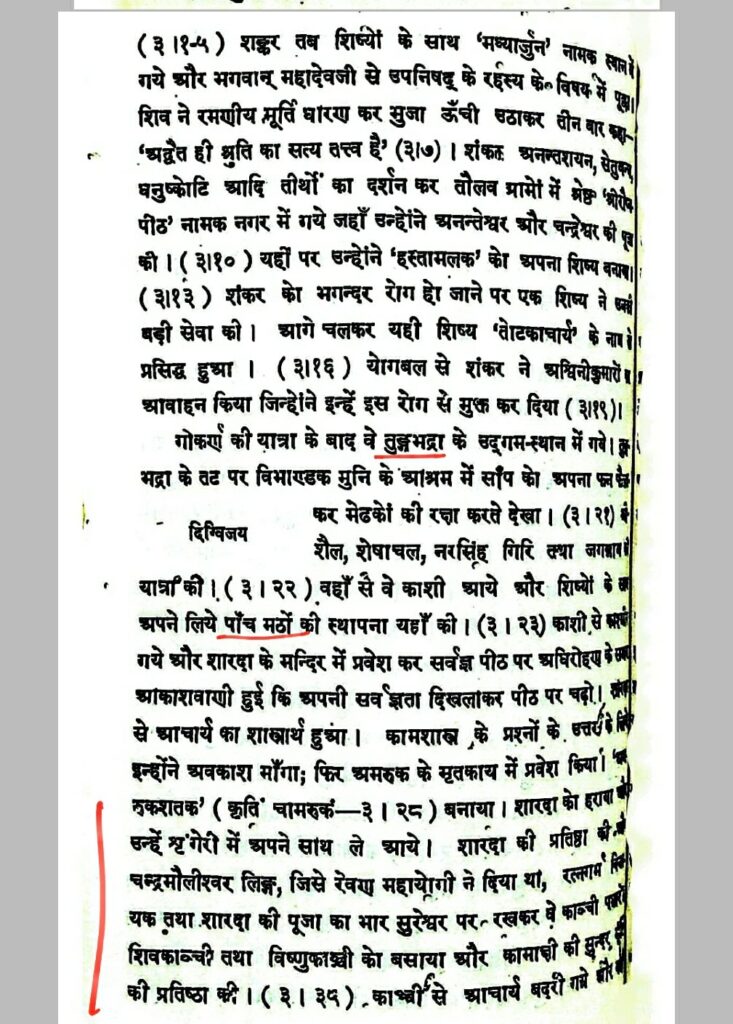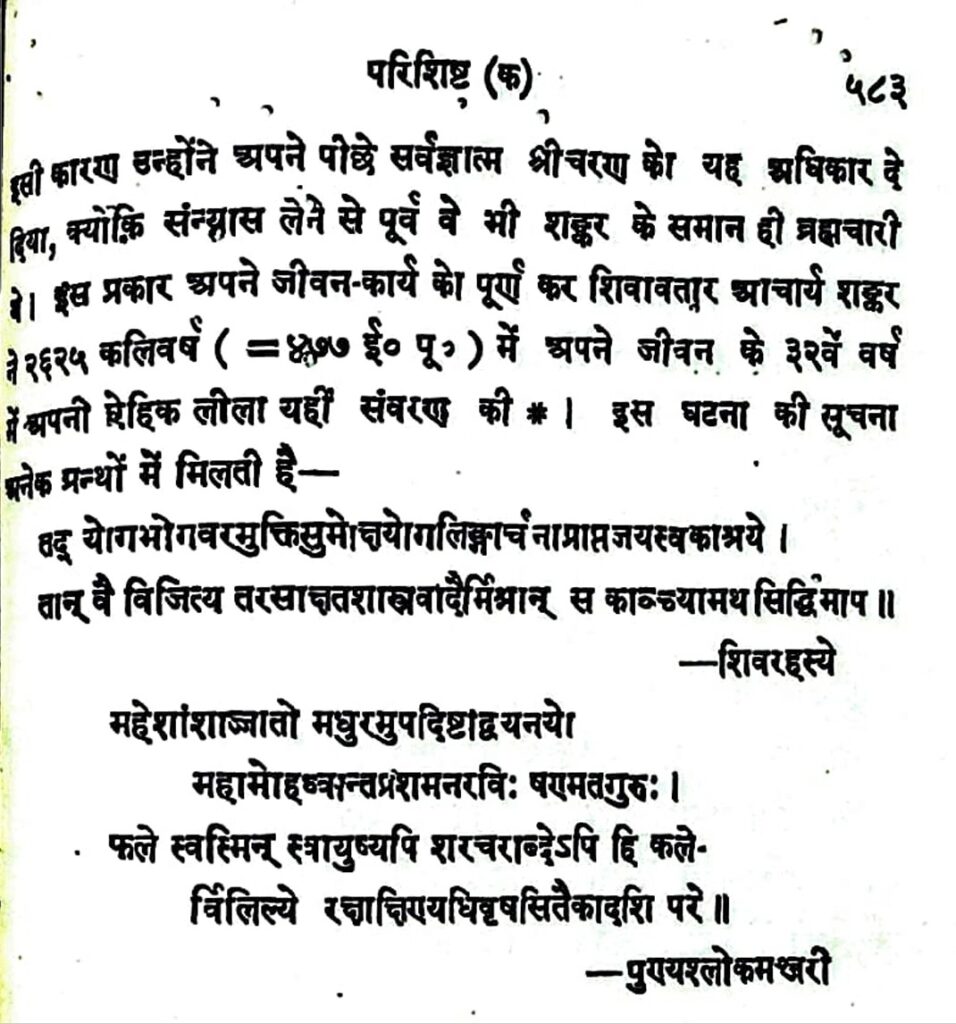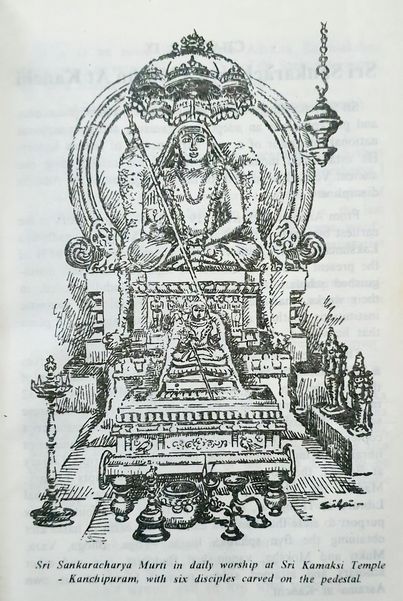













नानाभाष्यादृता सा सगुणफलगतिर्वैधविद्याविशेषै:
तत्तद्देशाप्तिरम्या सरिदिव सकला यत्रयात्यंशभूयम् ।
तस्मिन्नानन्दसिन्धावतिमहति फले भावविश्रान्तिमुद्रा
शास्त्रस्योद्घाटिता यैः प्रणमत हृदि तान्नित्यमाचार्यपादान् ॥
(श्रीमदप्पय्यदीक्षितानां न्यायरक्षामणौ)
“The rivers or the courses of devotion towards the diverse aspects of the Personal God attain their final calm only when they become one with the ocean of bliss (Ananda Sindhu) that unfolds itself at the moment of Ultimate Realization.”
Sri Sankara Bhagavadpada : The Shanmata Sthapanacharya – Shankara And Shanmata
“The celestial wish-yielding tree of Sankara taking its root in the Vedas, and spreading for branches the Shanmatas, gave out to the world at large a rich yield of the fruits of Illumination” thus says Anandagireeya.
“Those who came to scoff remained to pray” said Goldsmith. Those who came as disputants.. the leaders of the various sub-faiths became His disciples.
When Sri Sankara Bhavadpacharya took His abode in Kanchipuram in His last days, He sent out these disciples to propagate the worship of the six divinities within the Vedic framework. They did accordingly and reported back the success of their mission to the Great Acharya.
The 67th and succeeding prakaranas of Anandagiri’s Sankaravijaya, give an account of this. Paramata Kalanala, Lakshmana, Hastamalaka, Divakara, Tripura Kumara and Girijakumara were the disciples who spread the faiths in the different parts of Bharat,
Thus it is clear that Sri Bhagavadpada was Shanmata Sthapaka. He shed off His mortal coils in Kanchi only after the leaders of the six faiths, who were His disciples, reported to Him that the faiths had been stabilised throughout the nation in the new form given by the Achrya which really was their original form.
Iconography
It is significant that Sri Sankaracharya (like Dakshinamurti) is usually represented in sculptures with His four disciples who spread the philosophy of advaita. But, only in Sri Kamakshi Temple (Kamakoshta) and Sri Kanchi Kamakoti Peetam Srimatha (old Puja-griha)- His most important shrines
in Kanchipuram, six disciples are shown in the pedestal/ panel. They are the expounders of the Shanmatas. Two of them are not Sannyasins, their head not covered with cloth. But since they do not have the upavita they could not be brahmacharins or grhastas either. One may conclude they had been tantrics, newly won over to the Smarta tradition.



” The extraordinary composure of mind exhibited by his writings forms a striking contrast to those of the other reformers and philosophic writers, and would induce any reader to think that he had nothing to do with Buddhist or any other persecutions as Mr. A. Barth represents when he says that the disciples of Sri Sankaráchárya “Organized into military bands and constituted themselves the rabid (!) defenders of orthodoxy.”
With the exception perhaps of this single writer, every one else firmly believes that he was too philosophical to have hand in those persecutions.
Lastly, towards the end of his life he came to the south, but had to leave his body and this world in Conjeveram, at the early age of thirty-two. We think Conjeveram was the most probable place (of his Nirvana, for at present there is an image of him in the temple of the famous goddess Kámákshi, and judging from the style of architecture and the local traditions to the effect that his body lies buried underneath the image, which is now worshipped.
For Sri Sankaráchárya and his works we have a very high reverence. The loftines calmness, and firmness of his mind, the impartiality with which he deals with the various questions, his clearness of expression – all of these make us revere the philosopher, more and more:.”
– Pandit N.Bhashyacharya,
Adyar Oriental Library
10th October, 1889
25th March 44 B.C : The Birth Date of Sri Sankara Bhagavadpadacharya
Shri B.V.Raman in his book “Notable Horoscopes” has given a categorical statement that the 25th March 44 B.C was the Date of Birth Sri Sankara Bhagavadpadacharya . This according to him was on the basis of the reliable old records (Guruparampara patti) preserved in the Sankarite institution of Karnataka.
In the foot notes to his article on the subject, he says, “A learned Indian scholar who has written a book entitled Life and Teachings of Sankaracharya says that “in all this confusion of evidence it is safe to assume that Sankara flourished some time between the middle of the seventh and the first quarter of the ninth centuries”.
On what grounds he has come to this conclusion has not been made clear. There is no doubt confusion prevails regarding the year of Sankara’s birth but much of it could have been avoided if some of these scholars had taken the trouble to carefully examine all the relevant literature bearing on Sankara’s life and times, free from any prepossessions which are a concomitant of Western education.
A careful study of such authorities as Sankaravijayas of Madhavacharya, Anandagiri and Chidvilasa, Punya-sloka Manjari and the Guru Parampara list preserved in Sringeri Mutt reveals that Sankara was born definitely before Christ and not in the 7th or 8th century A.D. as oriental scholars-Indian and European-have made out.
It looks as though these scholars have confused Adi Sankara with his name-sake Abhinava Sankara who was the Guru of Kamakoti- peetha and the 36th in succession to Adi Sankara.
This Abhinava Sankara, a very learned and pious man, was born in 788 A.D. in the cyclic year Vibhava, solar month Vrishabha, on the 10th day of the bright half. It is said that like Adi Sankara this Abhinava Sankara also toured all over India, held discussions with learned men and conquered them intellec-tually. He died in A.D. 839.
Almost all authorities are unanimous that Adi Sankara was born on Vaisakha Suddha Panchami, at midday.
Suklapaksheshu panchamyam tithyam bhaskaravasave:
Madhyanhechobhijinnama muhurta subha veekshate.
As regards the year, Sukhacharya’s Brihat Sankara Vijaya and Chid- vilasa’s Sankara Vijaya make it clear that Sankara’s birth took place in Kaliyuga 2593, Sunday, Vaisakha Sukla Panchami, in Punarvasu nakshatra, at midday, when the Sun was in Aries, the Moon in Punarvasu last quarter and when Jupiter, Saturn and Mars were in kendras, exalted or in own house, Venus was exalted and Mercury was with the Sun. This date corresponds to 3rd April 509 B.C., the weekday being Monday. Un- fortunately except in regard to the Sun and Mercury, the positions of other planets (the Sun 20°; the Moon 71° 42′; Mars 252° 18′; Mercury 7° 6′ ; Jupiter 225° 30′; Venus 37° 18′; Saturn 338° 12′; and Rahu 41° 18′) do not tally with those suggested in the authorities.
As Prof. B. Suryanarain Rao says: “According to the records of Sringeri Mutt (Guru Parampara Patti) which are well preserved and reliable”, Sankara was born on the 5th day of the bright half of the lunar month of Vaisakha of the cyclic year Eswara in Vikrama 14. This corresponds to 25th March 44 B.C.
I am inclined to give greater weight to the reliability of this date as it is given in the lists preserved by the Gurus of Sringeri, and consequently, there was no chance of their having been tampered with.
Sankara’s Guru was Govindapada, who is said to have begotten by his Kshatriya wife, the great Vikramaditya. Sankara must therefore have lived about the time of Vikramaditya.”
“तस्मात् वेङ्कटगिरिं प्राप्य श्रीवेङ्कटेशमखिलकारणं शुद्धाद्वैतरूपं नत्वा…” (Anandagiri’s Sankaravijaya pr. 66)
” प्रदक्षिणं परिक्रामन् शेषाचलमतंद्रितः ।
गिरेरूर्ध्व समारुह्य स्नात्वा पुष्करिणीजले ॥
वेंकटेशं विलोक्याथ नमस्कृत्वा च भक्तितः ।
स्तुत्वा बहुविधैस्स्तोत्रे श्रीभूकान्तासमन्वितम् ॥ “
(Cidvilasa’s Sankaravijaya Ch. 26 – 3 & 4.)
Sri Sankaracarya climbed up Seshachala and had darshan of Lord Venkatesa. It was here that the Acarya sang the Vishupadadikesanta verses in praise of Hari.
श्रीवेङ्कटेशवृषशैलमुपेत्य योगी यन्त्रं जगत्रयवशीकरणं द्योतं तत् । चक्रे चराचरगुरुर्जगतां विभूत्यै श्रीशङ्करो निगमशेखरपारगोऽयम् II
The Markandeya samhita, records the Acarya’s consecration of the Dhanakarshana yantra in the Tirupati temple.
This tamil pamphlet published by an adherent of the Tunga Sringeri matha, contains a brief note on the Biography of Sri Sankara Bhagavadpada (as found in the 19th century Samkshepa Sankarajaya of Navakalidasa Madhava) and Tanjore Mahratta mural image of the Acarya with His Four Sishyas.
The Great Shankaracharya,
(Life-time From B. C. 42 to B. C. 10.)
ஸ்ரீஜகத்குரு ஆதிசங்கராசாரிய ஸ்வாமி ஜீவித காலம் கல்யப்தம் 3058 முதல் 3090 வரை அதாவது வயது 32. ஜனன பூமி மலையாளத்திலுள்ள காலட்டி அக்ரஹாரம், இம்மஹானது ஏழாவது ஆண்டிலேயே சகலகலாவல்ல ஜகத்பூஜியராய், 16-வது ஆண்டில் கோவிந்தபாதரைச் சற்குருவாய்ற்றேர்ந்து ஸந்நியாஸாச்ரமத்தைப் பெற்று ஸ்ரீசக்கிரம், நவக்ரஹ யந்திரம், சந்திரமௌளீஸ்வர லிங்கம், நரசிங்க சாளிக்கிராமமிவைகளை யளிக்கப் பெற்றார்கள். பின்னர் ஸ்ரீகாசிக்குச் சென்று….
(இவ்வாறே பிறவற்றைக் கண்டு கொள்க)
Sri Sankara Bhagavadpada had darshan of His Preceptor Sri Govinda Bhagavadpada at a place (cave) on the banks of the Narmada river.
Later, as per the wishes of Sri Govinda Bhagavatpada, Sri Sankaracharya crossed the forests of Central India and in due course reached the sacred mokshapuri of Varanasi where he stayed on for a pretty long time.
His illustrious commentaries on the Brahma – Sutras, the Upanisads, the Bhagavat Gita, the Vishnu – Sahasranama, the composition of the smaller pieces such as the Gangashtaka, the Manisha panchaka etc., are assigned to the period of His Stay at Kashi.
A verse in the Guruvamsa Kavya, remarks on the manuscript of this Kavya in the Annual report of the Mysore Archaeological Department for the year 1928 (Govt. Press, Bangalore) and an inscription in the Brahmendra Matha at Sivalaya Ghat in Varanasi clearly indicate Sri Sankara Bhagavatpada’s establishing religious institutions in the form of Mathas at important places which He visited or wherein He stayed for long.
The Guruvamsakavya speaks of the Acharya’s founding of *five mathas* at Varanasi,
four for His principal disciples and one for Himself.
” वाराणसीं योगिवरोऽधिगम्य भुजैरिव श्रीहरिरेष शिष्यैः ।
सहात्मना पञ्चमठानमीषां प्रकल्प्य तस्थौ कतिचिद्दिनानि “II
-(Verse 23-Canto III).
On pages 15 to 20 of the Annual Report of the Mysore Archaeological Department mentioned above, the following remarks on the Guruvamsakavya are found:-
” It follows that the author was the contemporary of Somasekhara II (1714-1739) of Keladi when Sacchidananda Bharati (1705-1741) adorned the pontifical seat at Sringeri.
(Kashi) Lakshmana Sastri, the author, seems to have been a very good scholar and as he composed the work under the orders of Sachchidananda Bharati. It may be reasonably presumed that he faithfully copied all available traditional information about the successive teachers of Sringeri “.
On page 16 of this Report the founding of an important Matha at Varanasi by Sri Sankaracharya is noted-
” The author says that He (Sri Sankaracharya) set up five Mathas and mentions the names of Sringeri, Kanchi, Badri, Kashi and Jagannatha.”
The following inscription in the Brahmendra Matha in Varanasi (referred to earlier) points to a line of Acharyas belonging to Sri Sankara Bhagavadpada Parampara:—
” जगद्गुरो शंकरस्य पारम्पर्यक्रमागतः ।
शिष्यः सन्मार्गनिष्णातः चन्द्रशेखर नामकः ।
तस्य शिष्यो विश्वनाथयतीन्द्रो योगिनां वरः ।…”
(1/2)


“The author has taken great pains to sift and test the Various dates till now in the market of Shanakra’s birth and has chosen 509 B.C. as the most likely.
We congratulate him upon having hit the right nail on the head; it will please him to know that the ancient Tibetian records support him. For Shankara came in just 57 years and 9 months after the Nirvana of Buddha. He need not have wavered in his decision and put forth an alternative date of 44 B.C. of the Sringeri matha.
The life account of Shankara contains nothing new; and the author might have thrown overboard much of the heavy useless ballast of the various Shankara Vijayas and sail his craft lightly…………. The works now current might more properly be from the pen of the “Abinava Shankara of the Eight Century.”